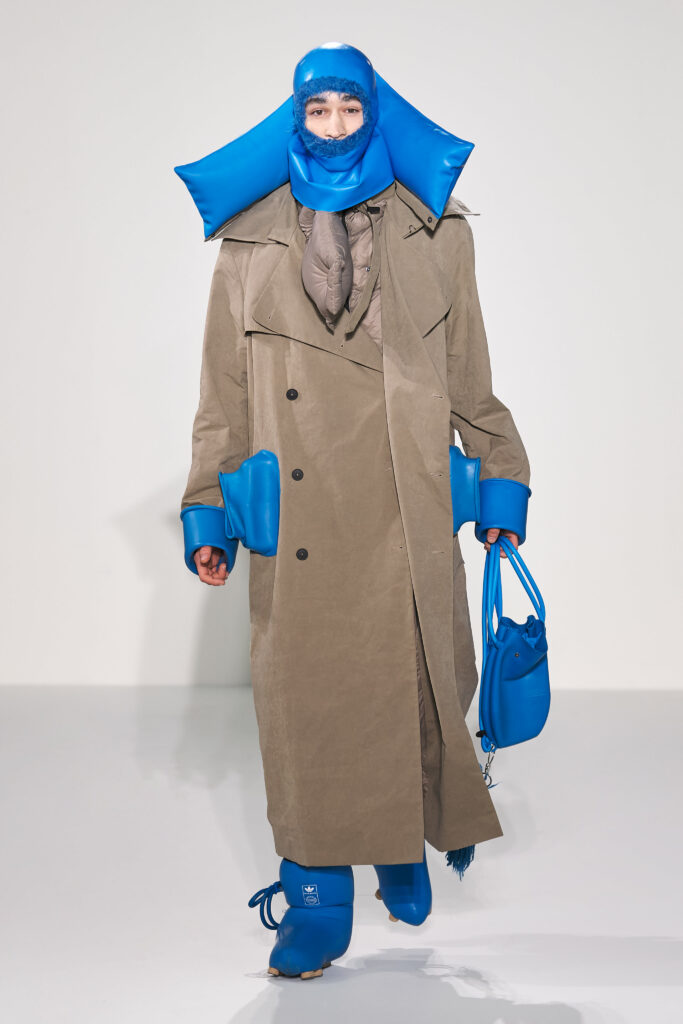Heightened Senses
Craig Green Autumn/Winter 2022

Tactility. Enclosure. Pleasure – both personal and public facing. Kink. Materiality. The list of conceptual talking points attendant to a Craig Green show is usually myriad, yet his latest collection – Autumn/Winter 2022 – is literally bursting at the seams with ideas.
Take, for example, the lineup’s final looks: Green has flipped the fuzzy and plush texture of mohair jumpers by turning them inward and bunching up the yarn against the body in a way that’s “enjoyable and suffocating” as the notes suggest. The switch creates not only a visual metaphor, but also an impression that’s rife with subversion: Usually, people aren’t able to experiencetheir clothing since the good stuff is on the outside. Why not turn it inside out — only then, does the pleasurable part of the clothing start to smother the wearer? Is this a reflection of the homebound claustrophobia we’ve all felt over the past two years? Thoughts abound.
Below, Green, who is set to show at Paris Fashion Week in June but moved his most recent catwalk back to his hometown of London due to Covid-19 hurdles, sounds off on the layers.
In your show notes, you speak of the collection’s “determined optimism.” Can you explain what you mean?
We didn’t really have optimism in mind in the beginning. Someone described this collection as being based in hyper-tactility. At the very, very beginning, we were really just looking at materials. I always think it’s strange that certain garments have the nicest portion of their construction on the outside. A lot of what’s in the show is reversible, so you can choose how you want to feel and how you want to be seen.
So this collection is about touch as much as it is about looks?
More so, I think, it’s about the materials, and what they can do, and what they signify. A lot of the pieces are also completely packable. They all pack into individual bags. The bags that the models are holding, they’re actually jackets. And again, this is very much for the wearer’s knowledge. We also have encapsulated Stan Smith shoes, with Adidas. But they’re wrapped. The wearer knows about them, and that might be it.
There’s some suggestiveness there. At the show, you spoke about this restriction and privacy almost as something sexual. Can you elaborate?
This also started from a different beginning. We had found images of a guy who lived his entire life inside an iron lung. It led to me thinking about sensory interactions. An idea surfaced — one of blocking certain senses so that others become stronger. It all ties back to creating something that’s about how we feel versus how we look. If you buy a leather jacket, it’s lined with something else, so you’re not really experiencing the leather. So, yeah, I guess the pleasurable element comes through in this.
Since Central Saint Martins, you’ve always focused on teams, groups — almost something of a tribe — in terms of workmanship and your aesthetic output. How has this been impacted, with so much disruption and fracturing of late?
Being part of something, of a workforce or a community, has become a bit broken in the last few years in the world. I do think it’s such an important thing. What we’re doing now is building on the ideas and codes we’ve done previously, but with a new outlook.
And, actually, I think that’s where optimism comes in. This collection is a great example of something really coming together. It’s sort of an accidental optimism. For example, the rubber factory we worked with only has three very specific colors. I liked the idea of limitation, similar to depriving one sense to boost another. I only had a set group to work with, and in the end, it worked. We created a rainbow. An imperfect one, not a crystal, shiny one. But a rainbow that looks how it’s supposed to look, which is never perfect. Sometimes things don’t have to be perfect to be optimistic.




